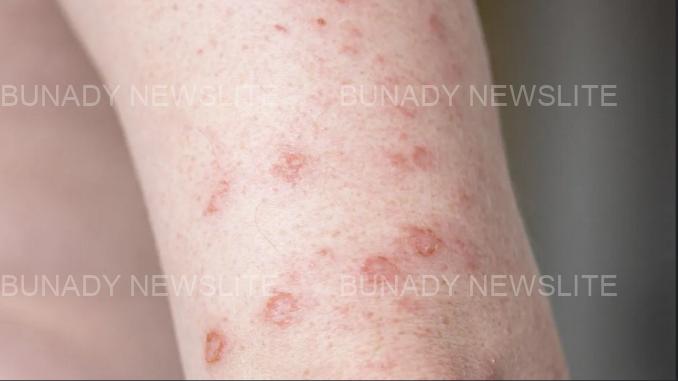Syphilis, a sèxually transmitted infection (STI), is caused by the bacterium Treponema pallidum. It has been a significant public health concern for centuries due to its potential complications if left untreated. One of the hallmark symptoms of syphilis is the syphilis rash, which manifests in the secondary stage of the infection.
In this article which is in accordance to healthline, we will delve into the details of syphilis, explore the syphilis rash, and discuss how to recognize if you have contracted this disease.
Syphilis is primarily transmitted through sexual contact, including vàginal, anal, or oral sèx. It can also pass from an infected mother to her unborn child during pregnancy or childbirth. The infection typically progresses in four stages: primary, secondary, latent, and tertiary. It is important to note that the syphilis rash occurs during the secondary stage.
During the primary stage, a syphilis infection begins with the appearance of a painless sore, known as a chancre, on or around the genitals, anus, or mouth. The chancre is usually firm, round, and indurated. It is highly contagious, and individuals may not always notice it due to its painless nature. If left untreated, the infection progresses to the secondary stage, when the syphilis rash emerges.
The syphilis rash is a characteristic symptom of secondary syphilis and often serves as a red flag for the presence of the disease. It typically appears several weeks after the initial exposure to the infection and can manifest in various forms. The rash may consist of small red or brown spots that can cover a large area of the body. These spots may be flat or slightly raised and can be rough to the touch. Sometimes, the rash may be accompanied by fine scales, giving it a more pronounced texture.
The syphilis rash commonly affects the palms of the hands and soles of the feet, but it can also spread to other parts of the body such as the trunk, extremities, face, or even mucous membranes. It is worth noting that the rash is not itchy, making it distinct from rashes associated with other conditions. Some individuals may also experience general symptoms during the secondary stage, including fever, fatigue, sore throat, swollen lymph nodes, and weight loss.
Recognizing the syphilis rash is crucial for early detection and prompt treatment. However, it is important to remember that not everyone infected with syphilis will develop a rash. This is why it is crucial to be aware of other signs and symptoms of syphilis as well. If you suspect you may have contracted syphilis or have engaged in risky sèxual behavior, it is essential to seek medical attention for testing and evaluation.
Diagnosing syphilis involves multiple steps. Firstly, a healthcare provider will inquire about your medical history, sèxual practices, and any symptoms you may be experiencing. They may also conduct a physical examination to check for signs such as the characteristic syphilis rash. However, relying solely on the presence of the rash for diagnosis is not sufficient, as other conditions can manifest similar skin abnormalities.
To confirm a syphilis infection, a blood test is typically performed. The most common blood test for syphilis is the treponemal test, which detects antibodies specific to the bacteria causing syphilis. If the treponemal test yields a positive result, a confirmatory test, such as the fluorescent treponemal antibody-absorption (FTA-ABS) test or the T. pallidum particle agglutination (TPPA) test, may be conducted. These tests help confirm the presence of a syphilis infection and determine the stage of the disease.
Once a syphilis diagnosis is established, timely treatment is essential to prevent further complications and transmission of the infection. Syphilis can be effectively treated with antibiotics, primarily penicillin. The specific regimen and duration of treatment depend on the stage of the infection and any additional factors, such as allergies or pregnancy. It is crucial to follow the prescribed treatment course and complete the full course of antibiotics as directed by the healthcare provider.
It is important to note that while treatment can eradicate the infection, any damage caused by syphilis prior to treatment may not be reversible. If left untreated, syphilis can progress to the latent stage, during which there are no visible symptoms. Without proper treatment, syphilis can eventually advance to the tertiary stage, causing serious complications such as cardiovascular damage, neurosyphilis (which affects the nervous system), or gummatous syphilis (formation of soft, tumor-like growths).
Prevention is always better than treatment when it comes to sexually transmitted infections. Practicing safe sèx by using condoms consistently and correctly can significantly reduce the risk of contracting syphilis. Regular testing and being aware of one’s sèxual health status are equally important, especially for individuals engaging in high-risk sèxual behaviors or with multiple partners.
understanding the syphilis rash and recognizing the symptoms of this infection are crucial for early detection, timely treatment, and prevention of complications. The syphilis rash in the secondary stage of syphilis is a distinctive sign that should prompt individuals to seek immediate medical attention.
Testing, diagnosis, and appropriate treatment with antibiotics are essential for managing syphilis effectively. By practicing safe sèx and regular testing, individuals can minimize the risk of contracting syphilis and other sèxually transmitted infections, ultimately safeguarding their overall health and well-being.

